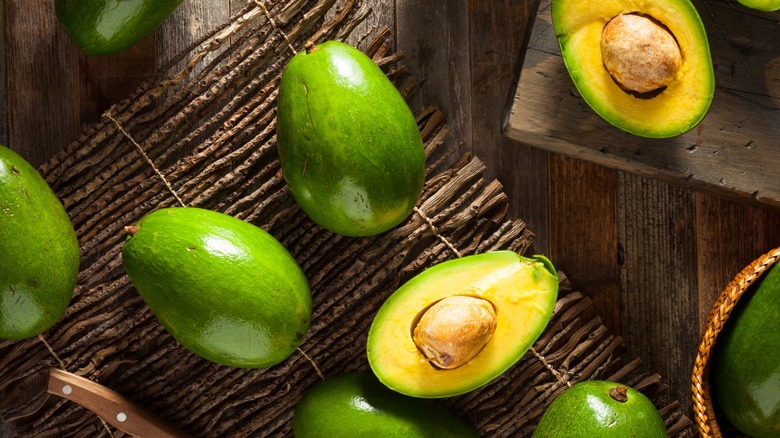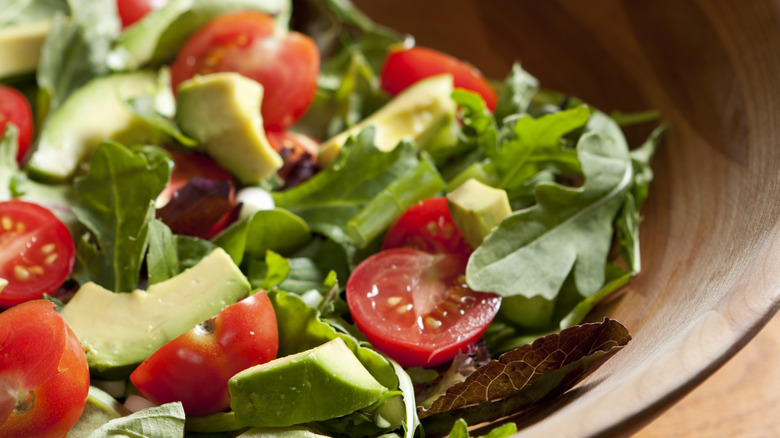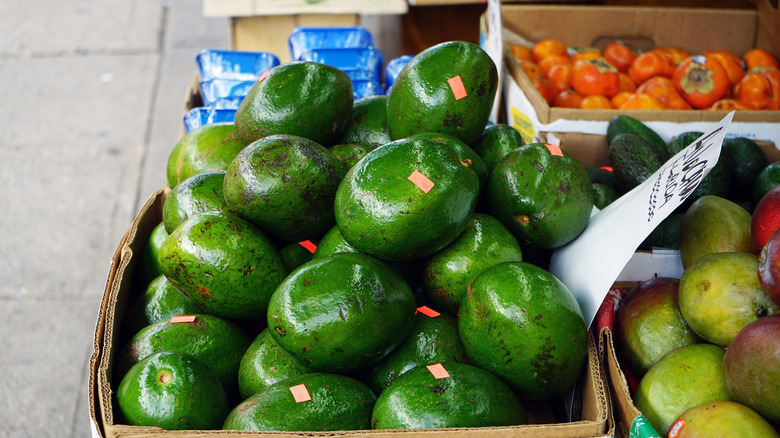For A Delicious Avocado Salad, You Actually Don't Want The Hass Variety
You know a Hass avocado is ripe when the outside is slightly brown and tender to the touch, with the flesh inside a bright green. This softness makes Hass avocados perfect for mashing into fresh guacamole, spreading onto toast, or slicing and garnishing another dish. But when an avocado becomes the base of your salad, not just a topping, you need an avocado that will stay sturdy and handle other ingredients like a leafy green would.
Instead of using the Hass variety to make an avocado salad, turn to the Florida variety. Florida avocados are not only much larger, but they retain a much firmer shape, making them perfect for the job of holding up in a hearty avocado salad recipe. You can slice up a Florida avocado to create long, thick pieces or dice it up to have small, uniform cubes. However you choose to slice it, the Florida avocado won't smush and squish when tossed in a salad or pierced with a fork for the first bite.
Why Florida avocados hold up to the task
Even though it's larger, the Florida avocado has also been nicknamed the "slimcado" because of its lower fat content than a Hass avocado. This is why the Florida avocado can hold up so well: With less fat, the avocado flesh is firmer. However, less fat also means the Florida avocado is not as creamy as a Hass avocado, which may turn off those averse to a chewy avocado bite. As for taste, Florida avocados are milder than the Hass variety, sometimes with a sweet or nutty side.
You may not want a slightly firm avocado for your guac, but ultimately, these characteristics make Florida avocados the perfect candidate for an avocado salad. First of all, you'll get more flesh from a Florida avocado than you would a Hass avocado, allowing you to make a large base for your salad. And when you mix in sliced onions, chopped herbs, and a homemade vinaigrette dressing, the Florida avocado will be able to hold up. A Hass avocado begins to soften and mush up when tossed together with other ingredients, but the milder Florida avocado stays strong as a vessel for your other salad ingredients and that delicious, tangy dressing. And if you add other healthy fats like nuts or olive oil, you've created a healthy balance by using an avocado variety with a lower fat content.
How to spot a great Florida avocado to use in your avocado salad
While you know a Hass avocado is unripe when the flesh is still green, that same indication doesn't apply to a Florida avocado. The skin of a Florida avocado stays a bright, light green, even when fully ripe, and is fairly smooth compared to the bumpy Hass. This might make it hard to know when your Florida avocado is ripe or even when it's overripened. Instead of looks, you'll have to rely on feel. You'll know it's ripe when the flesh slightly gives way. If it's too squishy to the touch, you've waited too long.
Since Florida avocados are larger, sometimes their shape starts to narrow towards the top near the stem, creating a pear-like shape. They also may not stay fresh for as long as a smaller Hass avocado, so make sure to use it up in your salad soon after it's ripened. If the Florida avocado is still rock-hard, it needs more time. But once it's ready, a Florida avocado makes for a deliciously mellow-tasting avocado salad infused with the flavors of your additional ingredients. Save the Hass avocados for recipes that call for a more creamy texture, like guacamole, and turn to a Florida avocado to hold up in your avocado salad.


